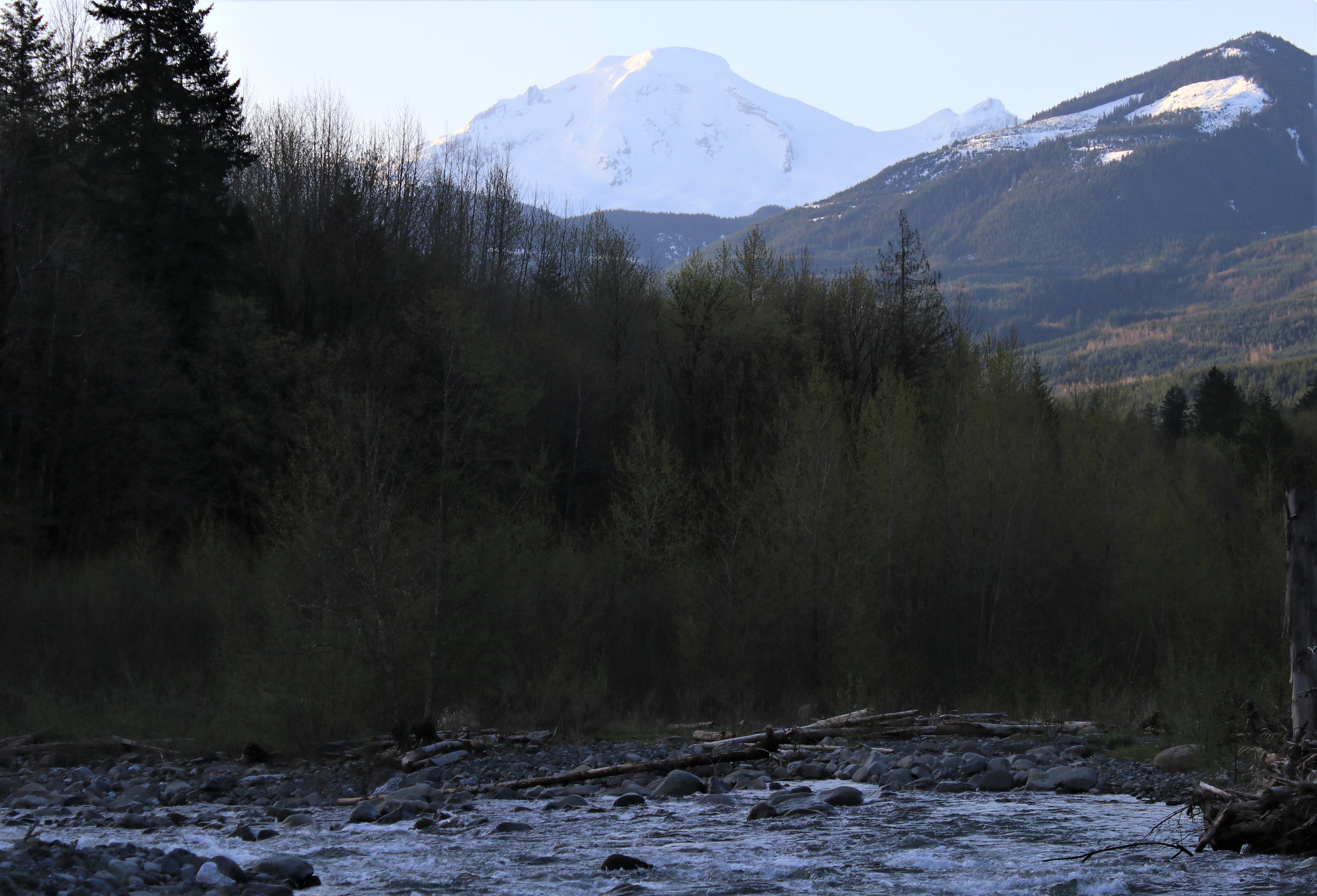
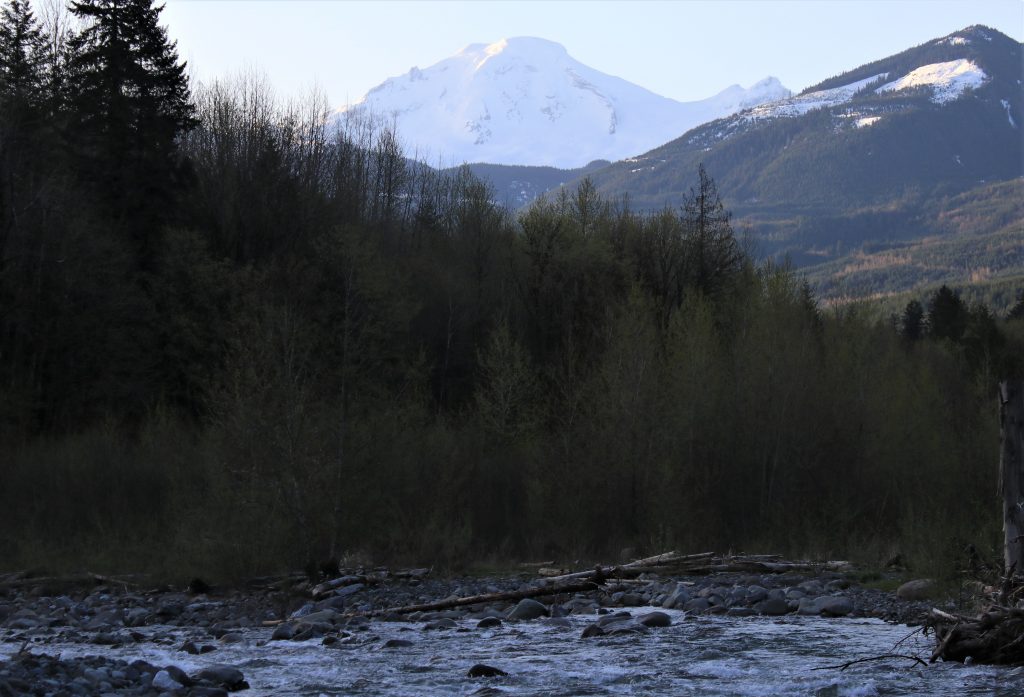
Canyon Creek, Whatcom Co., WA State
April 22, 2018 (Earth Day)
There were so many Earth Day activities to attend that I had some difficulty choosing which to spend my day with. I chose to go with the Whatcom Land Trust that has preserved over 20,000 acres from Farm land to salmon spawning habitat, to watersheds, to river corridors, to old growth forests and parks and has facilitated preservation of thousands more acres.
At least part of the reason I chose this site for my Earth Day activity was the promised magnificent views of Mt. Baker from along the creek. It was the right decision — see above photo.
Our work site was Canyon Creek, a Nooksack River tributary that is an important salmon and trout spawning stream that is subject to spring time floods after large snow melts. Typically the floods occur after mud slides dam the creek and then burst. The mudslides are at least partially man-made from over logging the steep hillsides above the creek. The State and County have expended a great deal of effort and money to mitigate the floods as they fill the creek with silt and literally muddy up the spawning beds. Also, there are recreational housing developments close by and owners were concerned that the creek erosion from the floods would get too close to their vacation homes.
This work party of about 30 adults and teens began by clearing several invasive plants from the riparian corridor alongside the Creek. After clearing some areas of the vegetational bullies that had elbowed their way into the previously pristine area, we planted some natural vegetation in hopes that it would flourish and prevent the invasives from getting a foot hold again and take over.
What is a weed?
As it turns out defining what is and isn’t a weed is not all that clear. I recall many years ago asking one of my biologist colleagues how to define a weed. After stammering a bit (I am sure there were many different thoughts racing through his mind at once) he said something like: “ It is whatever is growing in your garden that you don’t want there.” That made sense then and now.
Defining a weed is one of those “It depends” type of situations. For example, where does the dread or beloved dandelion come in? You can eat its greens, dry its roots to make a coffee substitute, and make wine out of its flower. (I tasted some once and it tasted like a putrid medicine.) Since it is everywhere and I don’t want it, it is a weed to me!! My grand kids still pick them for bouquets.
Fun fact: The name “dandelion” comes from the French “dent de lion”– lion’s tooth, which refers to the serrated leaves.
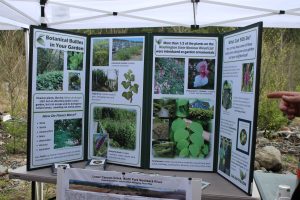
To help us out, we fortunately have a legal definition. In Washington State law, “ ‘Noxious weed’ means a plant that when established is highly destructive, competitive, or difficult to control by cultural or chemical practices.” [Revised Code of Washington (17.10.10)]. And, like felons, we have Class A, Class B, and Class C, Noxious Weeds.
Then the American Nursery and Landscape Association uses the term “Invasives” which I think fits a bit better. They say that “ invasive, non-native species are those that can or have spread into native wilderness or managed ecosystems, develop self-sustaining populations, and become dominant or disruptive to those systems.” This sounds like a weed to me.
What we did on Earth Day, 2018:
My crew started with an attack on an infestation of the lovely plant: Yellow archangel (Lamiastrum galeobdolon). This is really a rather attractive plant with oval, toothed, silver-white variegated leaves, native to Europe and Asia. It probably looks familiar to most people because it is commonly used in gardens and particularly in hanging baskets. It becomes a weed when it escapes the yard or is dumped in wooded areas where it proliferates rapidly. It forms dense mats of ground cover where it out competes native plants in forests and along riparian areas.
Yellow Archangel, creeping up on and surrounding a sword fern.
As I mentioned above, this area is close to a number of rather high-end “cabins” from which I imagine the archangel escaped, or was discarded before it headed for the creek.
We got down on hands and knees or crouched, and pulled up many bags full of this lovely pest.
In the midst of pulling up the archangels, we found another invasive, commonly called “Herb-Robert” (Geranium robertianum, Aka: Stinky Bob which is native to Asia, Europe and North Africa. Actually I thought it smelled a bit like cilantro and not at all unpleasant. But it had to go.
Stinky Bob looked familiar as I thought it looked similar to something in my yard. And indeed it was the same prolific plant that I fight at home but mine had red stems and these were green. Reading further I found that when Bob grows in good light, the stems become red. Bingo! Now I had a name for my own pest.
Stinky Bob amid some Sweet Woodruff (WaldMeister)
The third pest that we attacked was the onmi-present, English / Atlantic Ivy. There are over 400 cultivars of ivy used in landscaping but only a few are considered invasive. But they do take over a landscape or a forest if given a chance.
As with Yellow archangel, ivy is an escapee from yards. In the forest it climbs trees and forms dense mats which out-compete forest seedlings and promotes rot, smothers trees and blocks sunlight.
Treatment here was to pull up what ivy we could and cut the roots that climbed the trees.
Once the area was cleared of the invasives, we set about to fill in with some native plants so that they could get firm foothold before the pests get geared up again to take over.
Although we did not plant new ones, we cleared competitors that freed up Indian Plum plants that were being taken over by the yellow angels.
The After work tour:
Following the work party, we were invited to tag along on a short tour up Canyon creek. We did not take the long trail that went way up the canyon (thank god). I’ll save that for a later hike when there is no work party first. But we did get a ways up to see the creek roaring down having cut through 54 million years old Chuckanut Sandstone cliffs.
The tour quickly got into dense forest, mosses and tributary freshets pouring down the steep canyon walls. Some of the bags of weeds (?) that we cleared out.
Mosses, big enough to look like little ferns with some stinky bob creeping in.
A very fresh looking freshet tumbling down the hillside from recent snow pack melt and headed for the creek and framed by ferns and mosses.
This latter photo shows the creek coming out of the canyon. The logs in lower left and across the creek in the mid right are the remains of a logging road bridge from 60 to 70 years ago. It was this logging that made the hillside unstable and contributed to slides that dammed the creek causing the floods that are still being mitigated down stream.
We did not save the whole forest and stream on this Earth Day but we did advance a bit toward that goal. These work parties will continue as will the purchase and preservation of forest lands for future generations.
Do what you can.


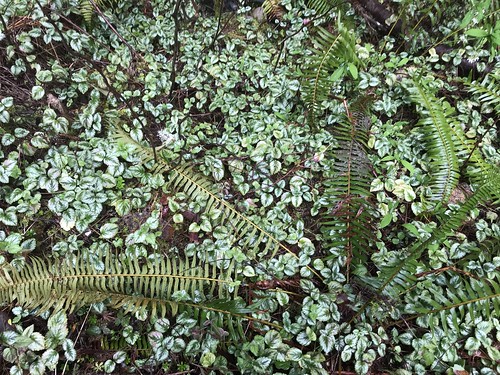
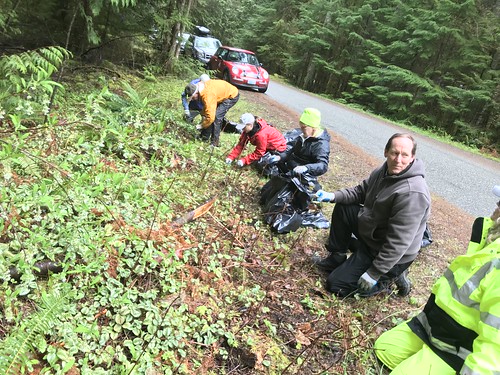
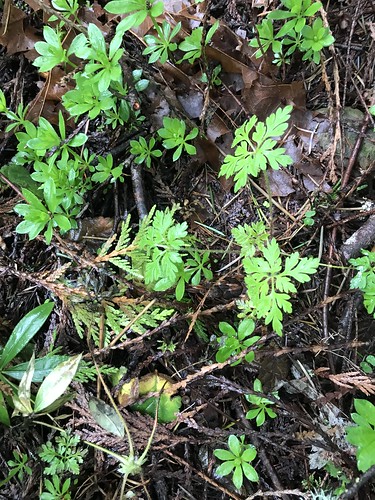

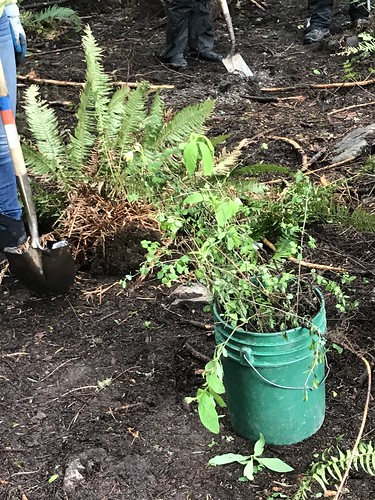


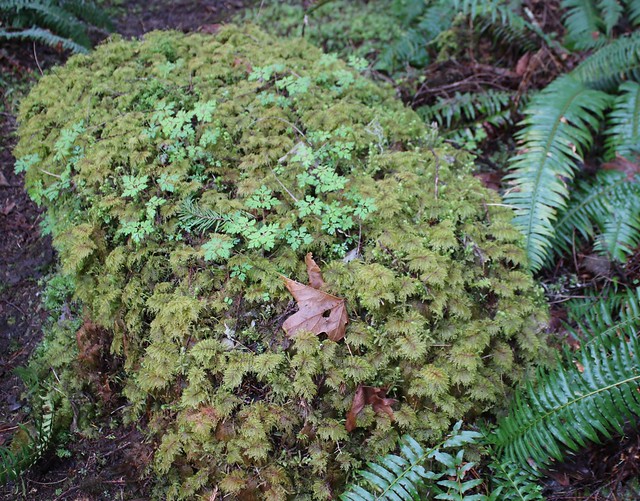


What happened on Earth Day in your Community? I did not think of the Other Washington the whole time I was in the mountains. That is therapeutic.
Thanks, RonK. What zone are you in? (I’ll look it up later but figured I’d ask you first). I’m just wondering , because I’ve never seen Lamiastrum spread here enough to be considered an invasive. I prefer Lamium anyway, but I’m rather astounded that yellow archangel has that much vigor.
Hi DoReMe.
thanks for your comment and question. We are generally in zone 7 but I am not sure how far that goes up the mountains. This is in a valley and is somewhat protected so it is probably not far off.
The plant is used around here as I mentioned in landscapes and in hanging baskets but it really seems to take off in the woods. I have since heard more of its invasiveness. Clearly it is not a “weed” but when not controlled it can become quite invasive.
Thanks for the post, RonK!
In Madison, the parks sponsored an Earth Day cleanup but had to move the event to April 28th because the recent snow and melt had made the parks a bit soupy.
The university held an Earth Day Conference sponsored by the Nelson Institute for Environmental Studies, named after Gaylord Nelson, the founder of Earth Day and former governor and Senator.
The calendar was filled with events as Earth Day is a BHD here in the librul oasis in the red state of Wisconsin. :)
I figured that Madison would have much going on for Earth Day. Too bad about the weather and the parks.
Yea for Gaylord Nelson.
{{{RonK}}} – “do what you can” is a lovely motto for just about anything. For Earth Day I mostly removed “invasives” from the most accessible of my flower gardens. :) The most invasive thing around here (at least as far as my neighborhood goes) is honeysuckle – a few of which were trying to get a foothold in that garden. sigh. It’s certainly gotten a foothold in the fence on 3 sides of my backyard. (I’d put in a picture of my DIL’s goats munching on that if I could figure out how to post a picture. LOL)
Thank you for the diaries and thank you for the conservation work you do. moar {{{HUGS}}}
Thanks Bfitz.
We have some native honeysuckle in the woods around here but it doesn’t seem to be much of a problem. It probably does not get enough sun to go wild.